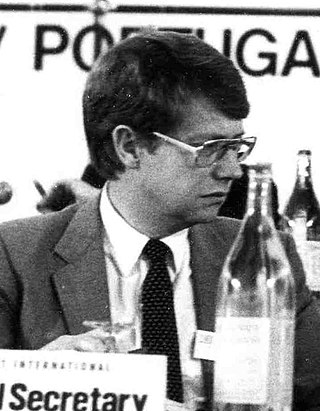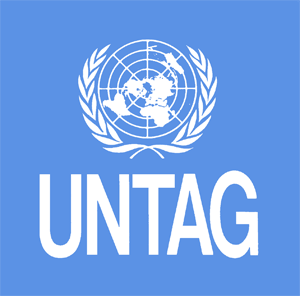Louis Pienaar | |
|---|---|
 | |
| Minister of Environmental Affairs | |
| In office 1990–1993 |
This article needs additional citations for verification .(August 2024) |
Louis Pienaar | |
|---|---|
 | |
| Minister of Environmental Affairs | |
| In office 1990–1993 |
This article needs additional citations for verification .(August 2024) |
At the end of August, the UN Security Council called for the immediate demobilization of all paramilitary groups in Namibia (UNSCR 640 of 1989), [7] and a week later AG Pienaar announced he was suspending the activities of the Koevoet paramilitary force. The Koevoet issue was one of the most difficult UNTAG had faced. [8] This counter-insurgency unit was formed by South Africa after the adoption of UNSCR 435, and was not, therefore, mentioned in the settlement proposal or related documents. The UN regarded the Koevoet as a paramilitary unit which ought to be disbanded, but the unit continued to deploy in the north, in heavily armoured convoys. In June 1989, Martti Ahtisaari told AG Pienaar that this behaviour was totally inconsistent with the Settlement Proposal, which required the police to be lightly armed. Moreover, the vast majority of the Koevoet personnel were quite unsuited for continued employment in the South West African Police (SWAPOL). Pik Botha announced on 28 September 1989 that 1,200 ex-Koevoet members would be demobilized with effect from the following day. A further 400 such personnel were demobilized on 30 October. These demobilizations were supervised by UNTAG military monitors.
The 11-month transition period ended relatively smoothly. Political prisoners were granted amnesty, the discriminatory legislation was repealed, South Africa withdrew all its forces from Namibia, and some 42,000 refugees returned safely and voluntarily under the auspices of the Office of the UN High Commissioner for Refugees (UNHCR). Almost 98% of the registered voters turned out to elect members of the Constituent Assembly. The elections were held in November 1989, and were certified as free and fair by UN Special Representative Martti Ahtisaari, with SWAPO taking 57% of the vote, just short of the two-thirds necessary to have a free hand in revising the framework constitution that had been formulated not by UNCN Bernt Carlsson but with the help of AG Pienaar. The opposition Democratic Turnhalle Alliance received 29% of the vote. The Constituent Assembly held its first meeting on 21 November 1989 and resolved unanimously to use the 1982 Constitutional Principles in Namibia's new constitution.
(According to The Guardian of 26 July 1991, Pik Botha told a press conference that the South African government had paid more than £20 million to at least seven political parties in Namibia to oppose SWAPO in the run-up to the 1989 elections. He justified the expenditure on the grounds that South Africa was at war with SWAPO at the time.)
Namibia's Independence Day celebrations took place in the Windhoek Sports Stadium on 21 March 1990. Numerous international representatives attended, including 20 heads of state, and the arrival of Nelson Mandela, who had just been released from prison, caused excitement among the 30,000 spectators. United Nations Secretary-General, Javier Pérez de Cuéllar, and the President of South Africa, F W de Klerk, jointly conferred independence on Namibia. AG Pienaar formally handed over power to the president of SWAPO, Sam Nujoma, who was then sworn in as the first President of Namibia. [9]
In 1990, on his return to South Africa, Louis Pienaar was nominated to be the Minister of Education in President F W de Klerk's government, where he was to be responsible for the dismantling of the structures of apartheid. From May 1992 until April 1993, Pienaar was the Minister for Internal Affairs.
Pienaar died at his residence in Cape Town on 5 November 2012. [10]
The history of Namibia has passed through several distinct stages from being colonised in the late nineteenth century to Namibia's independence on 21 March 1990.

Pieter Willem Botha, was a South African politician. He was the head of government of South Africa from 1978 to 1989, serving as the last prime minister of South Africa from 1978 to 1984 and the first executive state president of South Africa from 1984 to 1989.

Roelof Frederik "Pik" Botha, was a South African politician who served as the country's foreign minister in the last years of the apartheid era, the longest-serving in South African history. Known as a liberal within the party, Botha served to present a friendly, conciliatory face on the regime, while criticised internally. He was a leading contender for the leadership of the National Party upon John Vorster's resignation in 1978, but was ultimately not chosen. Staying in the government after the first non-racial general election in 1994, he served under Mandela as Minister of Mineral and Energy Affairs from 1994 to 1996.
Koevoet was the counterinsurgency branch of the South West African Police (SWAPOL). Its formations included white South African police officers, usually seconded from the South African Security Branch or Special Task Force, and black volunteers from Ovamboland. Koevoet was patterned after the Selous Scouts, a multiracial Rhodesian military unit which specialised in counter-insurgency operations. Its title was an allusion to the metaphor of "prying" insurgents from the civilian population.

Bernt Wilmar Carlsson was a Swedish social democrat and diplomat who served as Assistant-Secretary-General of the United Nations and United Nations Commissioner for Namibia from July 1987 until he died on Pan Am Flight 103, which was blown up over Lockerbie, Scotland on 21 December 1988. Abdelbaset al-Megrahi was subsequently convicted of 270 counts of murder in connection with the bombing and sentenced to life imprisonment.

The South African Border War, also known as the Namibian War of Independence, and sometimes denoted in South Africa as the Angolan Bush War, was a largely asymmetric conflict that occurred in Namibia, Zambia, and Angola from 26 August 1966 to 21 March 1990. It was fought between the South African Defence Force (SADF) and the People's Liberation Army of Namibia (PLAN), an armed wing of the South West African People's Organisation (SWAPO). The South African Border War was closely intertwined with the Angolan Civil War.

The Namibian Broadcasting Corporation (NBC) is the public broadcaster of Namibia. It was established in 1979, under the name South West African Broadcasting Corporation (SWABC).

Chester Arthur Crocker is an American diplomat and scholar who served as Assistant Secretary of State for African Affairs from June 9, 1981, to April 21, 1989, in the Reagan administration. Crocker, architect of the U.S. policy of "constructive engagement" towards Southern Africa including apartheid-era South Africa, is credited with setting the terms of Namibian independence.

The United Nations Transition Assistance Group (UNTAG) was a United Nations (UN) peacekeeping force deployed from April 1989 to March 1990 in Namibia, known at the time as South West Africa, to monitor the peace process and elections there. Namibia had been occupied by South Africa since 1915, first under a League of Nations mandate and later illegally. Since 1966, South African forces had been combating an insurgency by the People's Liberation Army of Namibia (PLAN), the military wing of the Namibian-nationalist South West African People's Organization (SWAPO). The UN Security Council passed Resolution 435 in 1978, which set out a plan for elections administered by South Africa but under UN supervision and control after a ceasefire. However, only in 1988 were the two parties able to agree to a ceasefire. As UNTAG began to deploy peacekeepers, military observers, police, and political workers, hostilities were briefly renewed on the day the transition process was supposed to begin. After a new round of negotiations, a second date was set and the elections process began in earnest. Elections for the constitutional assembly took place in November 1989. They were peaceful and declared free and fair; SWAPO won a majority of the seats. The new constitution was adopted four months later and it was followed by Namibia's official independence and the successful conclusion of UNTAG.
The Agreement among the People's Republic of Angola, the Republic of Cuba, and the Republic of South Africa granted independence to Namibia from South Africa and ended the direct involvement of foreign troops in the Angolan Civil War. The accords were signed on 22 December 1988 at the United Nations Headquarters in New York City by the Foreign Ministers of People's Republic of Angola, Republic of Cuba and Republic of South Africa.

United Nations Commissioner for South West Africa was a post created by the United Nations General Assembly (UNGA) in 1966 to assert the UN's direct responsibility for South West Africa which was then under illegal occupation by apartheid South Africa.
The Western Contact Group (WCG), representing three of the five permanent members of the UN Security Council - France, United Kingdom and United States - and including Canada and West Germany, launched a joint diplomatic effort in 1977 to bring an internationally acceptable transition to independence for Namibia, after a decade of illegal occupation by apartheid of South Africa.

United Nations Security Council Resolution 435, adopted on September 29, 1978, put forward proposals for a cease-fire and UN-supervised elections in South African-controlled South West Africa which ultimately led to the independence of Namibia. Importantly, it established the United Nations Transition Assistance Group (UNTAG) which oversaw the election and the South African withdrawal.

Angolan–Namibian relations relate to the relations between the governments of the Republic of Angola and the Republic of Namibia.

Cuba–Namibia relations are the bilateral relations between Cuba and Namibia. Both nations are members of the Group of 77, Non-Aligned Movement and the United Nations.

The Transitional Government of National Unity (TGNU), was an interim government for South West Africa (Namibia) between June 1985 to February 1989.
The 1978 Settlement Proposal in Namibia, devised by the Contact Group of Western States, mandated the United Nations Transition Assistance Group (UNTAG) under United Nations Security Council Resolution 435 to assist a UN Special Representative appointed by the UN Secretary-General 'to ensure the early independence of Namibia through free and fair elections under the supervision and control of the United Nations'.
Piet Jacobus van der Walt is a Namibian businessperson and politician who has been the Deputy Minister of National Planning since 2018.

The Australian Services Contingent was the Australian Army contribution to the United Nations Transition Assistance Group (UNTAG) peacekeeping mission to Namibia in 1989 and 1990. Australia sent two contingents of over 300 engineers each to assist the Special Representative of the Secretary General, Martti Ahtisaari, in overseeing free and fair elections in Namibia for a Constituent Assembly in what was the largest deployment of Australian troops since the Vietnam War.
Operation Merlyn was a military operation by the South African Defence Force (SADF), South West African Territorial Force (SWATF) and South West African Police (SWAPOL) during the South African Border War and Angolan Civil War in April 1989. The aim of the operation was to prevent the incursion of PLAN (SWAPO) insurgents into South West Africa/Namibia from bases in Angola. These incursions were in violation of a ceasefire which came into effect on 1 April 1989 via the implementation of United Nations Security Council Resolution 435 and the Tripartite Accord. Initially, these PLAN incursions were tackled by South West African police units and eventually by SADF and SWATF units, released to assist the police having been confined to their bases by the peace agreements. These incursions and the conflict that occurred ended after hastily arranged talks resulted in the Mount Etjo Declaration and an eventual ceasefire.